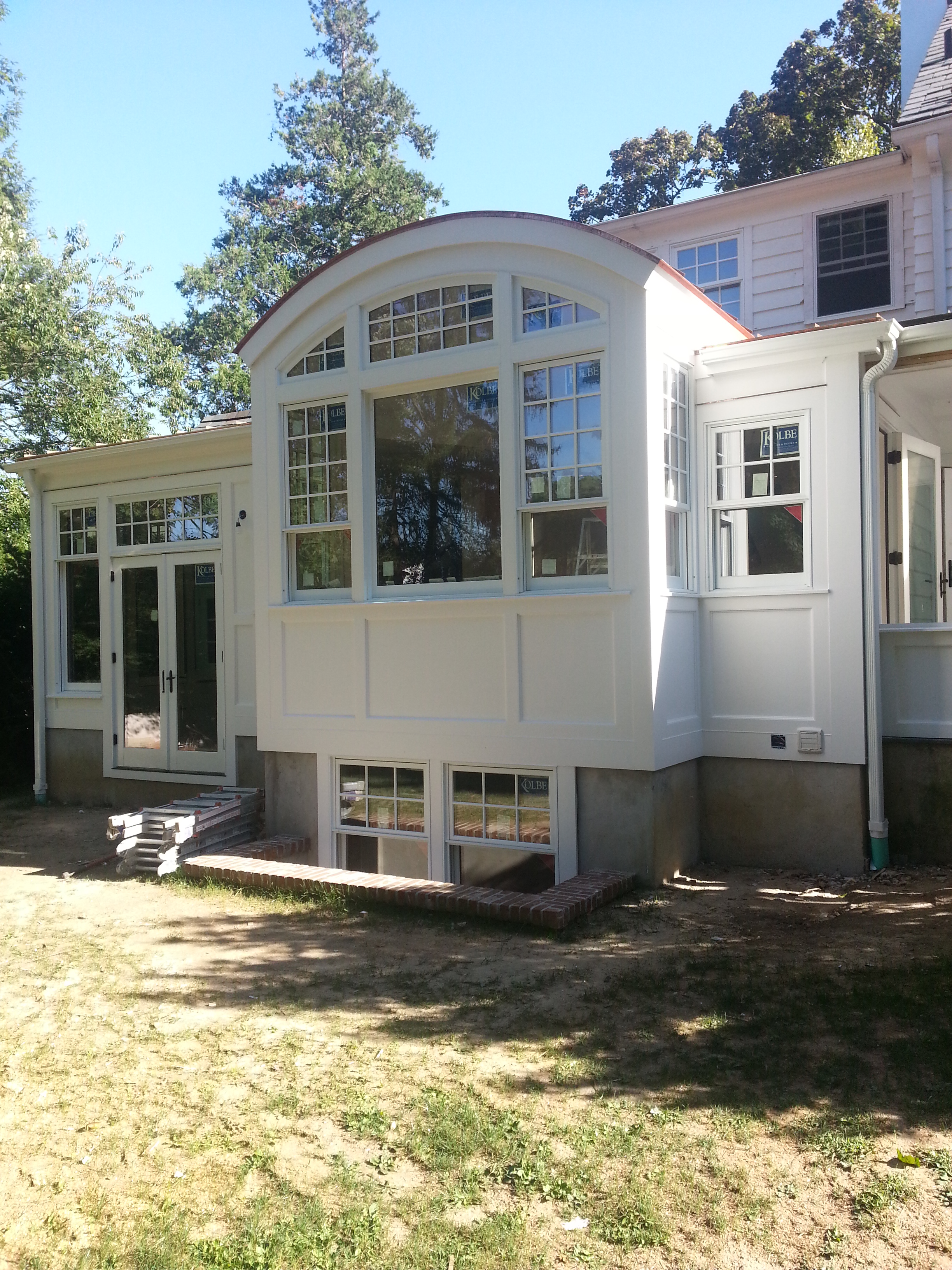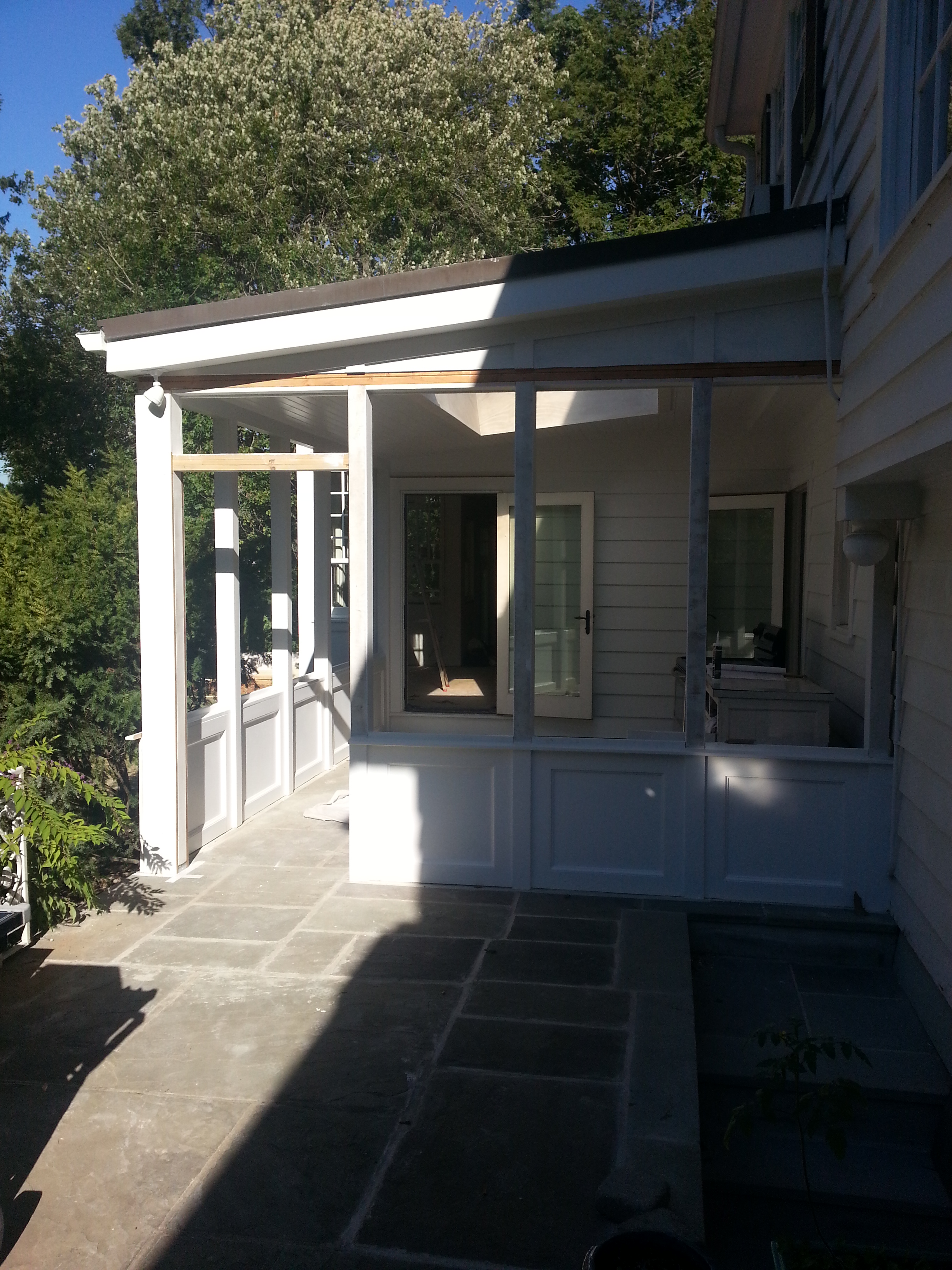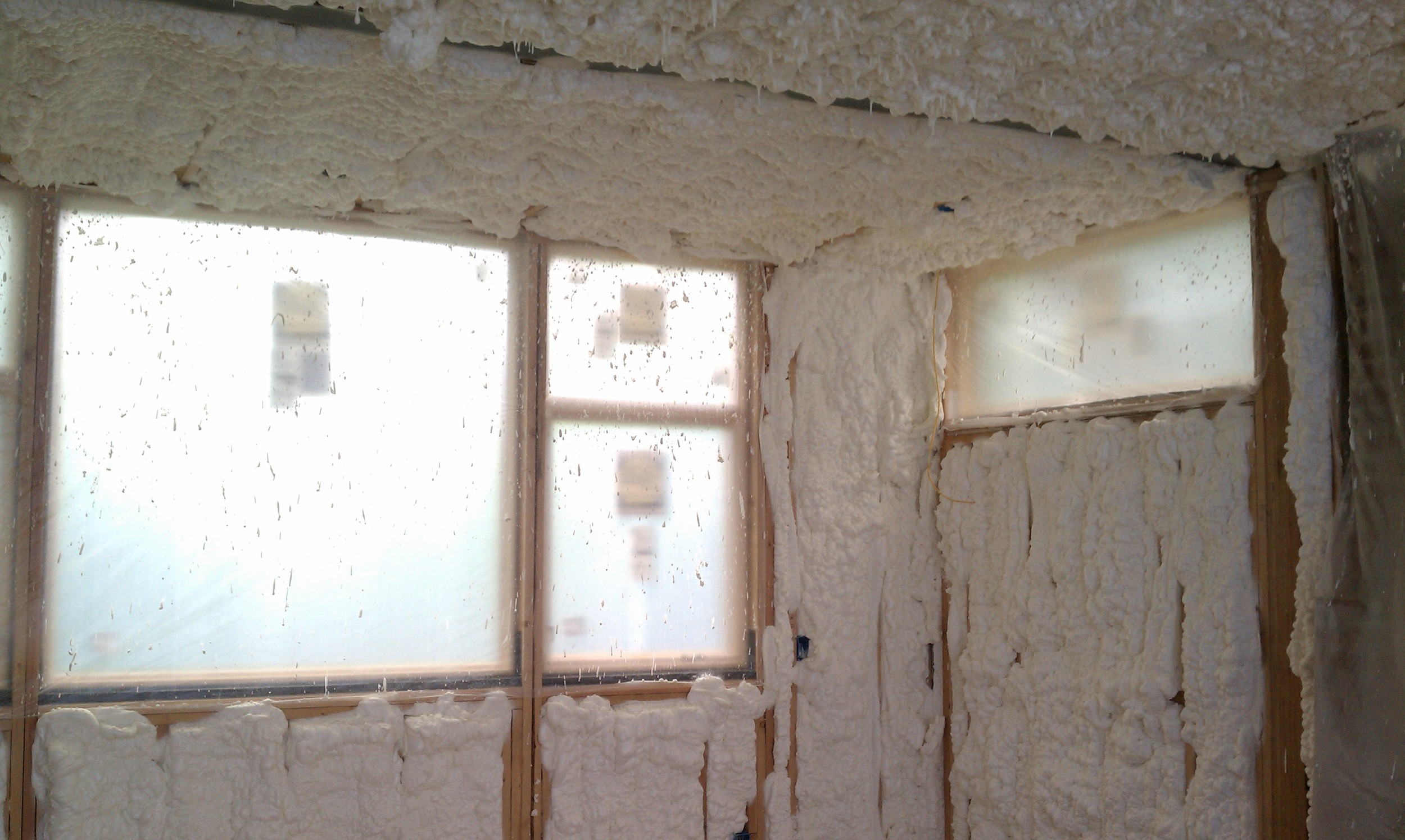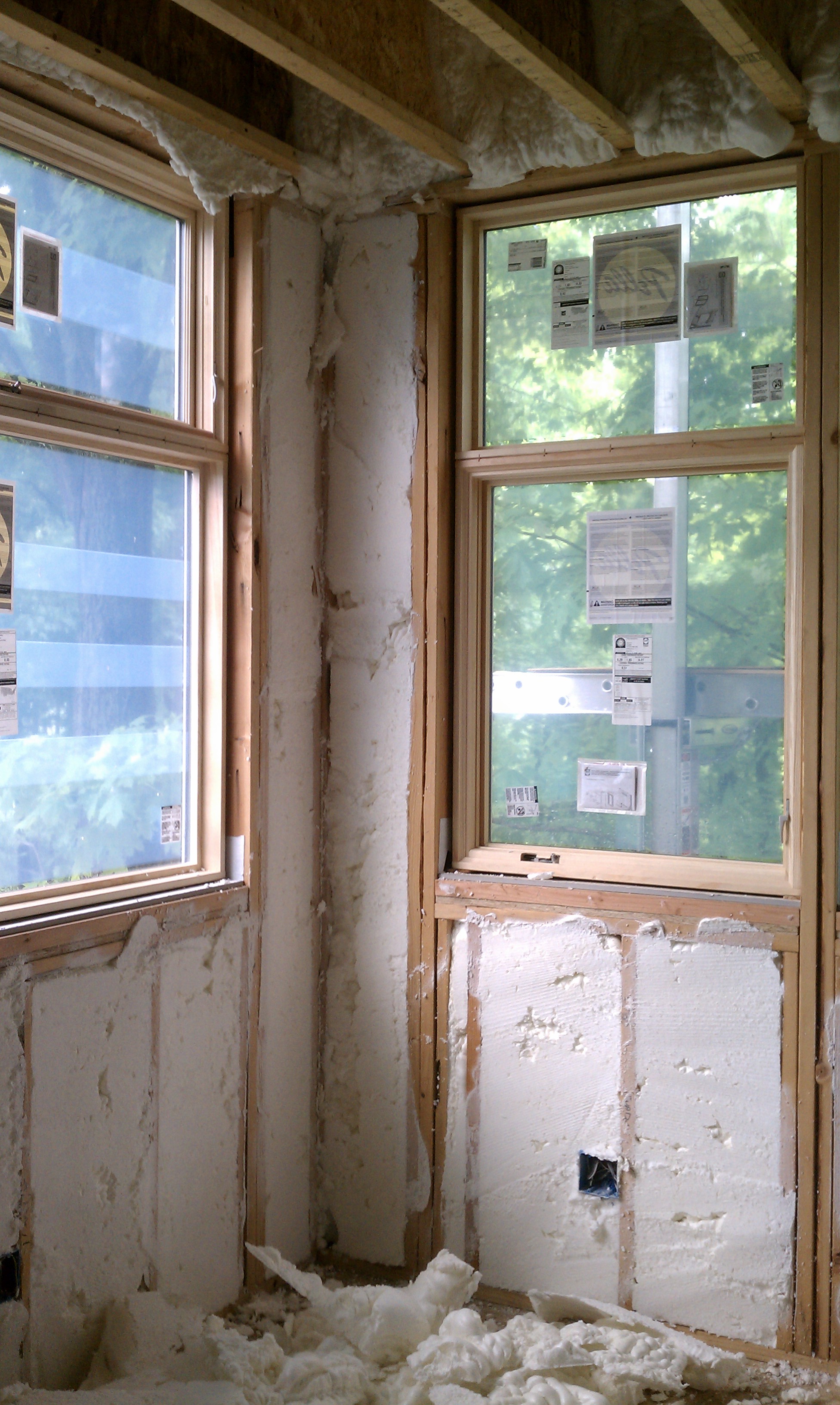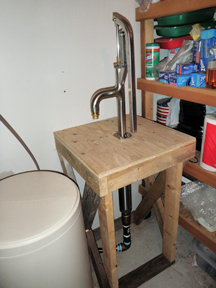Congratulations to our clients in Darien who recently completed their interior renovation. They also (single- handedly!) got their project LEED certified under the residential renovation category. Great job! We love how it came out as well. Its always fun to have clients with fantastic taste...
Climate Panel Says Upper Limit on Emissions Is Nearing
I usually only link straight green building articles to this blog, but this article in the New York Times today just feels too important not to re-post. The Building Industry accounts for approximately 40% of global emissions (manufacturing of materials, delivery, construction, waste and operations).
Making smaller, more efficient buildings, re-using what we can, and creating less waste has never been more important.
HERE IS LINK TO THE NEW YORK TIMES ARTICLE:
http://www.nytimes.com/2013/09/28/science/global-climate-change-report.html?h
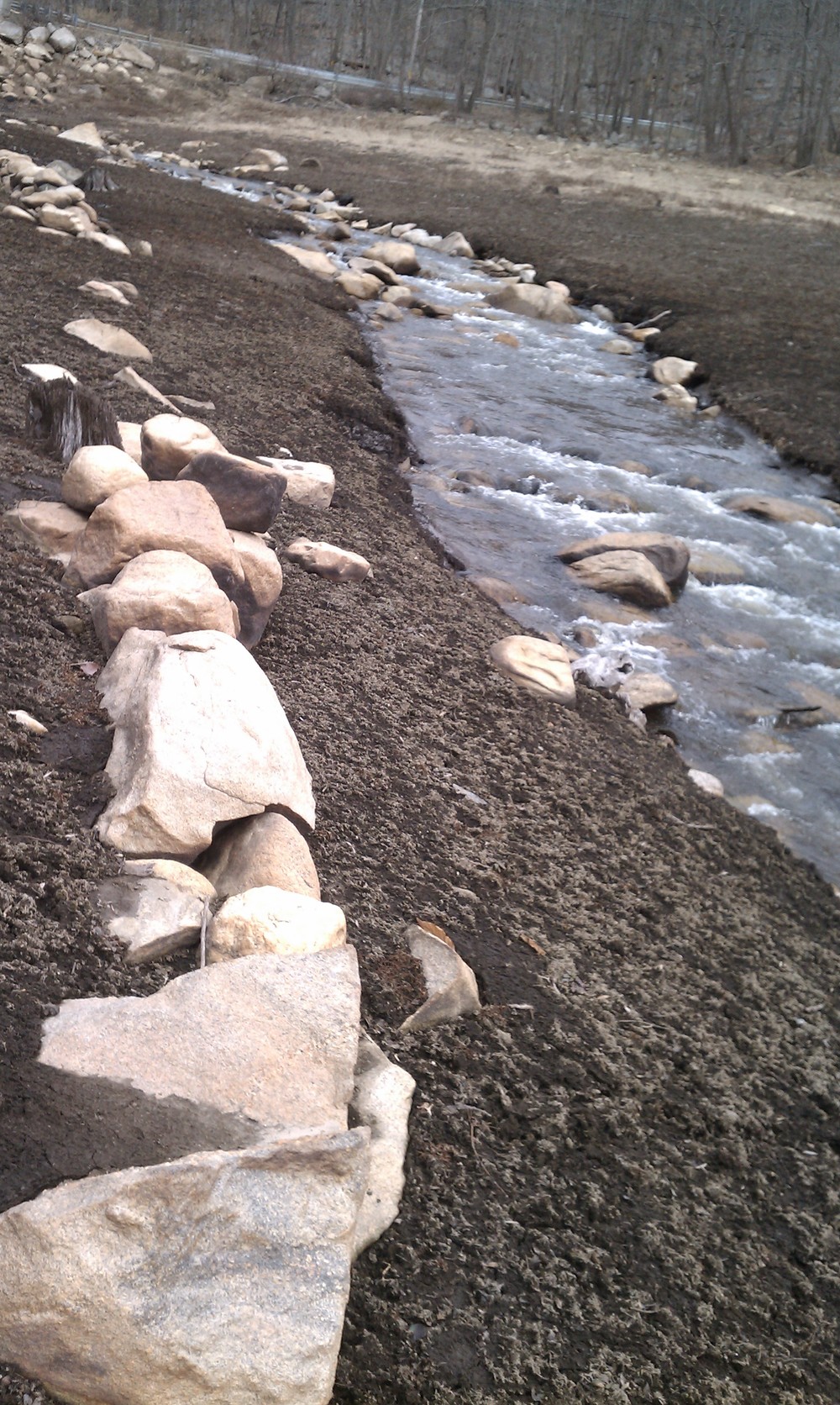 Photo: Elizabeth DiSalvo
Photo: Elizabeth DiSalvo
Jewel Box in Scarsdale
This kitchen addition in Scardale has been in the works for about 2 years. After a good amount of care and watrering it is growing into a beautiful gem!
The Kitchen will go in in the next few weeks and finishing touches after that. The clients had a large old Maple from their a relatives yard cut and milled. It will make both the floor and the kitchen center island. Here is a veiw from the kitchen towards the future built in breakfast nook and beyond to the back yard:
The screen porch is a bright and airy retreat:
The Underground House
I just want to give a shout out to friends and clients in Virginia who are building an underground house. This amazing and interesting couple with 3 grown children are basically building this house themselves. We helped them with some early design work but basically Kim and Bill are driving this ship.
Imagine the Teletubbies beautiful grass covered dome house, change the shape a bit, add a garage and this is what you get. Click on this link to Kim's Blog to read all about it. Be sure to check back to earlier posts to read all about the hows and why!
Holy LED!
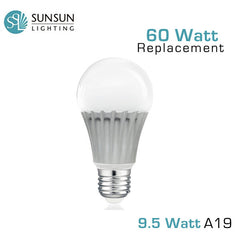
Wow!!! LED 60 watt equivalent bulbs for $9.88! I can't believe it! There really are no excuses after this.
When I first bought this bulb for my family room they cost about $55 each. I was a believer, so I splurged. That was 4.5 years ago and I bought four of them for the most used room in the house. These lights are on 8-12 hours a day... still going strong, no sign of trouble. They save a ton of electricity and are much, much, much more beautiful than those pesky CFL's.
I, for one, have always always hated CFL's. I feel like CFL's were this really bad phase we had to suffer through, like fashion in the 80's. Blech!
Luckily, I went to RPI for undergrad and RPI happens ot have one of the most progressive lighting labs in the world. So I had insider info that better bulbs were coming. SO. I quietly waited while my horrid CFLs took forever to turn on and burned out quicker than they were supposed to and had wretched colors that never matched and basically drove me crazy.
Then, the first realistically priced and nice light quality LEDs appeared. By realistic, I mean less than $100 bucks for a bulb that was to last 15-20 years. It would work out to something like $5/year and that was ok with me. I started changing over. Every year since then the price has been dropping (just like CFL's, just like PV Panels, just like giant TVs, just like computers...)
So, now I say to all of the naysayers! and cheapskates! :
Go get yourself some LED's and BE HAPPY! Yay!
Insulation for the House on the Lake
Insulation has been installed in the house on the lake in Ridgefield.
In this house we are using all spray foam insulation. We have been going back and forth with using spray foam over the last 8 years. If works very well but there is always this question about overall health and off gassing. (see below)
We are insulating with a combination of .8lb Open Cell Foam (walls) and 2lb Closed Cell Foam (under the first floor deck and in the cathedral ceiling/ roof.) Closed cell is much more dense, has better vapor barrier qualities and a higher R value but it more expensive and much harder to cut. We put it in places where we really need the vapor barrier.
This house is now basically built like a thermos! The full envelope (walls, roof, floor) are all super insulated and it will take very little energy to heat and cool this house!
Basic stats:
House size: 2,100 sf
Floor: (entire separation of house first floor and crawlspace, basement and cantilevered open air below)
Approx 9" of 2lb Closed Cell Foam (R6/inch)= R 54
Walls: (2x6's at 24" o.c.) 5.5" of .8lb Open Cell Foam (R4.4/inch) = R24.2
Roof: (Flash of 3" Closed cell Foam (R18 Total), filled 6.5" with Open Cell Foam (R28.6 Total)) = R46.6
We are conditioning the space with:
2 Mitsubishi, ducted mini-splits. One per floor.Will provide both cooling and heating.
Back up heat sources:
1 high efficiency gas fireplace insert. This unit will be able to heat most of the house, certainly the 1st floor open floor plan which is approx. 1300 sf. This unit does not depend on electricity and will be placed in the old first floor fireplace. (The foundation and the old brick and stone chimney were the only things left form the original house).
1 direct vent gas fireplace unit in the second floor Master bedroom. 2nd floor is approx 800 sf.
You can see a couple of pictures below of the process. The first shows the walls and ceiling right after the foam has been sprayed in....
1 ERV (Energy Recovery Ventilator)for whole house fresh air and ventilation. Important when you are making such a well sealed, insulated house. But don't forget you are still allowed to open all of your windows when you live in a well insulated house!
Fans We are also installing fans- both room fans and bathroom fans which are low energy use ways to move air around and reduce the use of other heating adn cooling sources during the shoulder seasons.
The first photo (below) shows the open cell foam as it is when first blown in...
...The second photo shows the foam after walls have been shaved. The shaving allows for the drywall to go in flat while still filling the wall cavity completely. You can also see here how the rim joists (the part above the ceiling along the outer walls of the house) are insulated.
Next step, drywall!
What about Foam?
Yes, Foam DEFINITELY off gasses when it first goes in. You don't really want to be there when it is installed and you can still smell it strongly after the first few days and lightly there after for about 2 weeks. But then you really don't smell it anymore. So is it still offgasing? And if so how badly and how bad is it for you? Does it become inert and therefore basically innocuous? These are all really good questions and the answers are so far pretty debatable.
I feel fairly comfortable with the health concerns once the foam has offgassed to the point of no odor and the drywall goes up and the house is finished. (In most cases it is months between foam insulation going in and the house being finished enough for occupation by the home owners.)
However, one concern is fire. We had clients who had foamed their detached garage and finished it to make it an office a few years back. They had a small garbage can fire that really just scorched the drywall and was put out with little harm done. BUT the office forever after smelled horribly of the burnt foam and know one wanted to go in there anymore. The area of foam had to be fully removed to get rid of the smell.
But foam works so well! and is Very easy to install. It really does have so many benefits.
What are the alternatives? Well, we like cellulose and rock wool and cotton batts and even blown in fiberglass. (Usually all of these are in combination with some sort of rigid house wrapping insulation.)We don't use fiberglass batts as they are pretty ineffectual. (You can read a lot more about insulation in the 'Tech Talk' section of the website.)
Enjoy the warm weather~
My New Car ~ The All Electric Nissan Leaf!
Last week I spent the weekend test driving the 2013 Nissan Leaf. I got hooked! It is strange. After driving this amazingly quiet and extremely smooth little car, a few things happened:
#1 All gas fueled cars suddenly appear filthy to me. It is - I am guessing- how people started to see the old coal locomotives after electric ones started to become common. When I drive my old beloved Suburu now I just think 'eeew, gross'.
#2 I started really getting into the game of 'how far can I go on a charge?'. The Leaf monitors your driving style for energy efficiency and lets you know when you are doing well by growing a little tree icon on the dash board display. Cute. I really wanted to grow that little tree. I drove like my foot was on the MOST fragile egg!
#3 I started really paying attention to how many trips I was making to town and back. With a kid and a puppy and poor cooking skills, man I drive back and forth a lot!
Anyway, they convinced me. I am getting my new Leaf tomorrow. It will be this color blue and I am going to put an electric car charging station outside of my office in the center of town (landlord, willing).
I am really excited about this new adventure. The Leaf gets about 100 miles to a charge. A charge takes about 4.5 hours and costs approximately $3.00. I figure I will charge it up about 2 or 3 times a week, lets say 10 times a month. SO that is about $30.00 a month in fuel.
The way the car uses electricity is interesting too. I was expecting a sort of simple correlation between how many miles you can go and how much your battery is charged. Not so. Basically there is a little 'gas guage' on the dash board display and when the car is fully charged it might say '100 miles'. (Meaning you have 100 miles to go before you run out of charge. ) Then as you drive the number on the gas gauge keeps going up and down. Basically if you are powering hard or going up a hill you might buzz through 5 miles on the gauge, but you have only gone 2 or 3 miles on the odometer. (I immediately thought 'what the heck! not cool!'). But then as you drive on and go down hill coasting , or stop at stop signs, you start to get some of those miles back. (There is another fun little display on the dash that shows you when you are using energy and when you are producing energy. Also addictive to watch and challenge yourself with!)
I tested the gas gauge thing over the weekend. After going 45 miles in actual distance, I had used 46 miles on my gas gauge. After going 85 miles of actual distance I had used 83 miles on my gas gauge. Pretty accurate, but it is like the curve of a graph, don't focus on the high and low points, focus on the curve.
What about charging? good question. You CAN charge the car from a normal 110 outlet. Or you can get a car charging station and charge in a third of the time. Basically it takes about 4.5 hours to charge with the 240 volt car charging station. With the 110 outlet it takes a good 12 hours to fully charge. (I tried it at home over night. I plugged it in before dinner and was shocked to see it still charging at 6am when I went out to walk the puppy.) I immediately decided that I am getting 2 car charging stations, one for the house and one for the office. But then I found out how much they cost ! These charger stations can run between $750 and $1400 easily. Yikes. (As usual, Bob was right. Yes Bob I wrote that down.)
I have decided I am going to get one at the office and make it part of the entire Fine Green Homes experience. Any fellow hybrid or electric car user friends out there, come on by and fuel up!
New Office Sign!
Lake House Progress
The siding is starting to go up. We are using untreated cedar with a rain screen behind. The house will grey naturally and required basically no exterior maintenance. This picture shows why we will not have solar panels on the house at this point. The low slope roof faces due south, however the clients love the trees. The trees will do an excellent job of shading the house in the summer and when you are inside the house it feels like you are in a tree house! Really nice. So trees won out of over solar power. It is possible that they will be installed at a later date or at another location on site if the right combination of trees fall during the next crazy storm... (hopefully not on the house! Yes, we considered that...)
This is the north-west corner of the house. The old chimney has been repointed and a high efficiency gas insert will be installed in the fireplace opening inside. The stove will be enough to heat most of the house if the power goes out. On the second floor there will be another smaller gas direct vent unit in the master bedroom to take care of any lapses in heat on the second floor. On the roof deck we will install and outdoor fireplace at the chimney- purely for fun. There will be a flat deck and steel cable railings over the gently sloped roof that is on the roof deck now. The roof is sloped to drain. There is a large scupper in each far corner that will draw the water away from the house.
More coming soon!
Wilton Go Green Festival!
Come see us this Sunday May 5th at the Wilton Go Green Festival! Wilton has one of the best and most interesting Green Festivals around. It has been well established over the years by a truly dedicated team. We hope to see you there! The weekend promises to be beautiful!
11-4 pm, Sunday May 5th, Town Center, Wilton CT

THIS IS AN ARTICLE FROM CT MAGAZINE APRIL '13 ISSUE ~ Darien LEED Home Featured
When Hurricane Sandy slammed into Connecticut late last October, 94 percent of Connecticut Light & Power’s 8,000 customers in the town of Darien lost power. Fifty streets in the coastal community were inaccessible to restoration crews; 20 homes were eventually declared uninhabitable. The power—and with it heat, lights and appliances—stayed off for as long as two weeks. As temperatures dropped, one of the worst storms in the state’s history cast the affluent Fairfield County community into a cold, dark gloom...
Walking Forward Into The Past
Below is an article put out by The Taft School regarding the project we are workign on there!
http://www.taftschool.org/alumni/onephotoleft.aspx?storyname=59north
A Green Home
Walking Forward Into the Past
03/23/2013

Proposed house design in Greek Revival style

Trillium ArchitectsAt boarding school, a house is more than just a home. It’s also a place to host team dinners and advisee feeds—and for most faculty, it’s just a hop, skip and a jump from the classroom or athletic field.Roughly a third of the Taft faculty live in dormitory apartments, but after a few years of late night check-ins and the occasional fire drill, many faculty (frequently with growing families) move into nearby campus housing. The school now owns about 35 homes (some are two-family) in the neighborhood, most of them adjacent to the playing fields.Last summer the school renovated the Rectory building (acquired with Woodward Chapel) and this summer plans to build a state-of-the-art green home designed by Architect Elizabeth DiSalvo, Trillium Architects, a leader in the field of residential green building, thanks to a gift to support the school's commitment to faculty housing and environmental stewardship."This project perfectly embodies two key strategic priorities," says Headmaster Willy MacMullen '78, "improved faculty housing and a commitment to environmental stewardship. We are so lucky that we received a generous grant from a Taft family to make this possible."Current plans are for a 2,400 square foot, two-story home with two-car garage, 3 bedrooms and 2.5 baths. A new foundation will be located further back from the road and oriented to optimize use of passive and active solar energy (see box below for more details). The school had originally hoped to renovate the existing home on the site, but discovered numerous problems and began to consider the benefits of building a new home that could be at once historically sensitive to the neighborhood and also a model of environmental sustainability."What Taft is doing with the plan for this new home," says DiSalvo, "is something I call 'walking forward into the past.' I got this term from a Native American in New Mexico. Basically it means using the technological advances we have to day to revive the intentions of the past. In housing that means getting back to nature and building intelligently based on what nature tells us and gives us. For example, the sun warms us naturally, therefore, it makes sense to turn a house toward the sun to let the low winter sun in and provide overhangs to shade us from the hot summer sun. This sort of building was obvious when people lived in tune with nature and the seasons. Modern technologies have brought us away from that knowledge. Why not use the wisdom of the past to form our houses and then add the significant benefits of modern technology to make a house that can be close to net zero and last for generations to come. And when its long life cycle is done, it can naturally biodegrade and become part of the earth again. This is what Taft is doing with the house at 59 North Street."Before proceeding, Taft consulted with the town historian, who discovered no architectural or historical significance to the home, and then, following all permitting requirements, presented the design to the Watertown Historic District Commission, which approved the new plan unanimously.Still, the proposed removal of the home stirred some controversy after the public hearing.“Taft followed all the required procedures and is tremendously excited about building a home that will be beautiful, efficient and responsible,” says Headmaster Willy MacMullen ’78."The vote of the Commission was unanimous," wrote Jean C. King, chair of the Watertown Historic District Commission. "The Commission consulted with Mr. John Pillis, the town historian, during its deliberations and Mr. Pillis agreed with our decision."Taft has not razed any homes in the Historic District since the district’s creation. The Annex was the last known structure removed, now 50 years ago—for fire safety concerns.The home at 59 North Street bears little resemblance to its 19th-century original. What is visible is likely a 1920s creation. Not much remains of the home's historic character after repeated additions and renovations."In every era of history, houses have been built to higher and lower quality levels," says Di Salvo. "Some are truly gems, fantastic examples of the design, technologies and riches of their age. Others are utilitarian structures that are erected because someone needs a quick and inexpensive shelter. Should we save everything ever built more than 100 years ago? Not necessarily. If we fast forward 100 years would you expect our grandchildren to save a poorly built '70s ranch or a very poorly built '80s McMansion simply because they are old?" "The home, while old, has been renovated and added on to over the years," says Business Manager Gil Thornfeldt, "and the current house could not feasibly be renovated to provide a safe, environmentally conscious home for a family."Taft School actively seeks to preserve the town’s historic character and has demonstrated that commitment through the preservation of the old town library (now Walker Hall), Christ Church (Woodward Chapel)—both of which are still used to host events that are open to the public—as well as the Rectory and another home on North Street that was renovated several years ago. The Academy Building and the Woodward Chapel Annex are both scheduled for renovations this year. A rear view of the current structure at 59 North Street, which shows multiple additions to the original structure.
Green Features
The goal of a HERS (Home Energy Rating System) Score less than 30, optimally less than 20. High R-Value with very low air infiltration and little thermal bridging make the heating and cooling of the house incredibly efficient, requiring very little fuel.
Building Envelope:
Walls: R45 (code requires R21) double stud walls filled with 12" dense-packed cellulose
Roof: R65 (code requires R38) underside sheathing ‘flashed’ with closed-cell foam insulation (approx. 3” = R20) and filled with dense-packed cellulose approx. 12" thick (R 45)
Basement: R20 (code requires R10) 3" closed-cell foam with drywall over stud framing
Slab: R28 (code requires R10) Slab will have 4" EPS foam below it.
Windows: R5 / U.2 Min (energy star suggests and code requires R3.5/ U.28)
Air Infiltration Goal of 1.0 ACH@50 Pascals airflow Maximum
HVAC Equipment
-Super high-efficiency Ductless Mini-splits (2) for heating and cooling
-ERV (Energy Recovery Ventilator) to re-coup heat and moisture from outgoing air
-High Efficiency Gas (or propane) on demand Hot Water Heater with Solar Thermal Back up
-High efficiency, super low emission wood stove for power failures or extreme cold spells.
Electrical
-Photovoltaic solar panels for powering lights, outlets, etc., and Minisplit heating and cooling system with possible battery backup.
-Ceiling Fans for circulation of air in each bedroom and major living space
-LED Lights throughout
-Energy Star rated Appliances
Water
-Collect all water from the roof in underground holding tank connected to a drip irrigation system for the adjacent school garden.
Materials
-Painted cedar shingle exterior, applied as "rain screen," an old-fashioned method (rarely practiced now) that allows for a continuous airspace behind the shingles to keep them dry yearround. The ability to get wet and then dry makes the shingles and the paint job last a very long time.
-Strive for natural and sustainable materials for the interior and salvage materials, like wood flooring, from the existing home where possible
Ground Cover and Plantings
-Water-permeable drive and walkways of stone or gravel to reduce runoff
-Native plantings that require no active watering
Want to be OFF the GRID for that next STORM??
I DO!! I have found 3 super cool products this week that I plan to get for my own house.
- One is a stove that cooks your dinner and charges your small electronics!
- The second is a hand pump that you can hook up directly to your normal well!
- The third is an Awesome version of a wood firebox insert!
Here is a bit of info about each:
1. (COOKING + CHARGING) The Biolite Stove http://www.biolitestove.com/
What do you need when you are out of power for a week? Water, heat, a way to cook. Then also nice would be a refrigerator, an electrical source and a hot shower.
Biolite makes both the Camp Stove and the Home Stove that solve two problems- cooking and charging small electronics.. Currently only the Camp Stove is available to the general public. The Home Stove (which is the one I can't wait to get!) is still in testing- mostly in 3rd world countries in need I believe- and is not yet able to be purchased. A good friend of mine who is a leader in the green building movement has the Camp Stove and loves it.
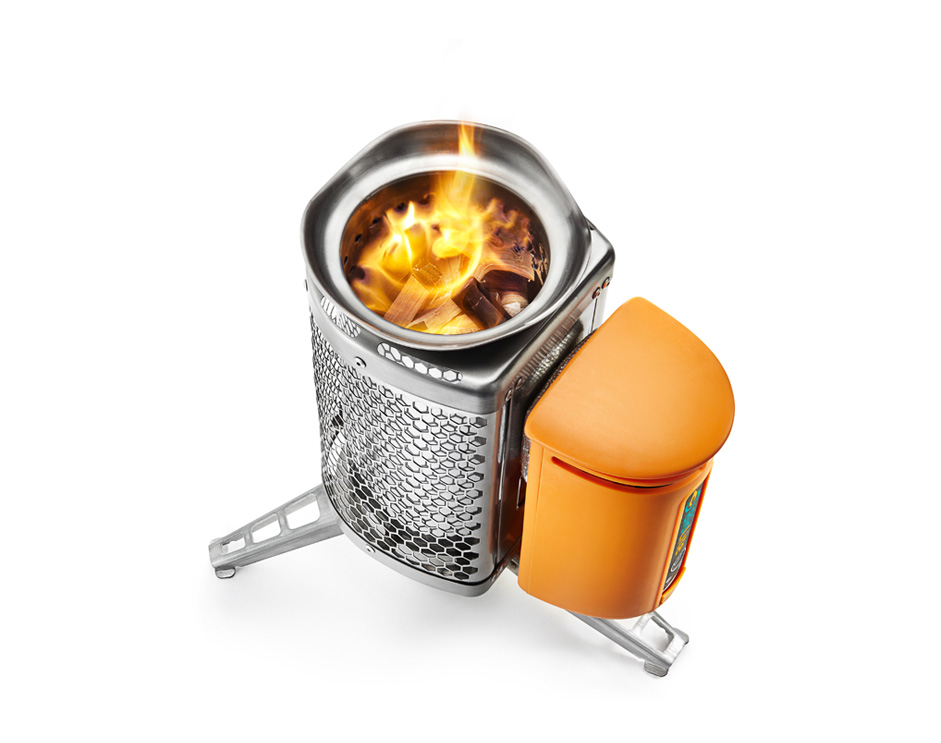
Here is a blurb form the company:
Using our patent-pending technology, BioLite has created a low-cost biomass cook stove that, by converting waste heat into electricity, reduces smoke emissions by up to 95% while simultaneously providing users with the capability to charge mobile phones and LED lights.
2. (WATER) The Bison Hand Pump http://www.bisonpumps.com/
I have been thinking about this for the last year. The water problem is usually solved- in our house- by a giant bathtub filled with water before the power goes. This is not a bad answer and a jacuzzi tub of water can last 4 people for a week of cooking, cleaning and toilet flushing. But WOW! wouldn't be great to just be able to pump that water sitting down there in your well??
These guys have made that a possibility. Here is a blurb from the Bison web site:
We want to emphasize that Bison Deep and Shallow Well Hand Pumps can be installed in the same casing as your existing electric submersible or jet pump in nearly any situation. There seems to be some doubtful conversation out there that this cannot be done. Please give us a call and our sales and technical staff will guide you through your specific installation. As the ol' saying goes "Never say never"!
3. (HEAT) The Wittus Phenix Green Wood Insert http://www.wittus.com/
I love this stove. Here we have an alternative source of heat that is perfect for a blackout situation. It uses wood in a super clean way. It pumps out a lot of btu's very efficiently. It can be ducted to serve more remote parts of a house and it can be controlled by a thermostat. It brings in 100% outside make up air AND it looks great. The Fireplace Insert uses natural convection to disperse the heat and does not rely on a fan. Many of the high efficiency stoves that are installed really need the fan to make the heat fill the space. I appreciate this low tech/ super efficient answer to the heating problem. Plus the fact that it is operates with much lower levels of pollutants makes it a truly acceptable answer to the problem. AND since all have a lot of trees and wood around after the last hurricanes, it seems like a no brainer.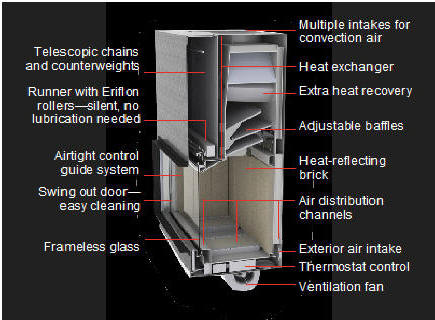
From Wittus:
The Phenix Green zero-clearance built-in fireplaces from Bodart & Gonay of Belgium set a new standard for wood burning stoves. Equipped with the latest retractable door technology, it allows the user to enjoy the fire with the door open or closed.
With the door lifted, you enjoy the warmth of a genuine open fire. With the door closed, you get a full view through the panoramic window and with the maximum efficiency range of 76%—82% and exceptional heating power.
Phenix Green are available in four models: the 75, 85, 95, and the 120. The technological advances along with low CO and particulate emissions makes the Phenix Green fireplace an ecologically friendly product.
All models include these special features:
- multi-ducting capability, which enables heat transfer in up to 6 additional rooms
- a linear, seamless steel frame
- an upward lifting/forward tilting door feature that make it easy to clean the glass viewing window
- the outside air system uses 100% direct air intake
- the thermostat keeps the temperature regulated
- choice of Class A or Heatilator chimney system
- an optional fan capability.
House Design and Energy Efficiency
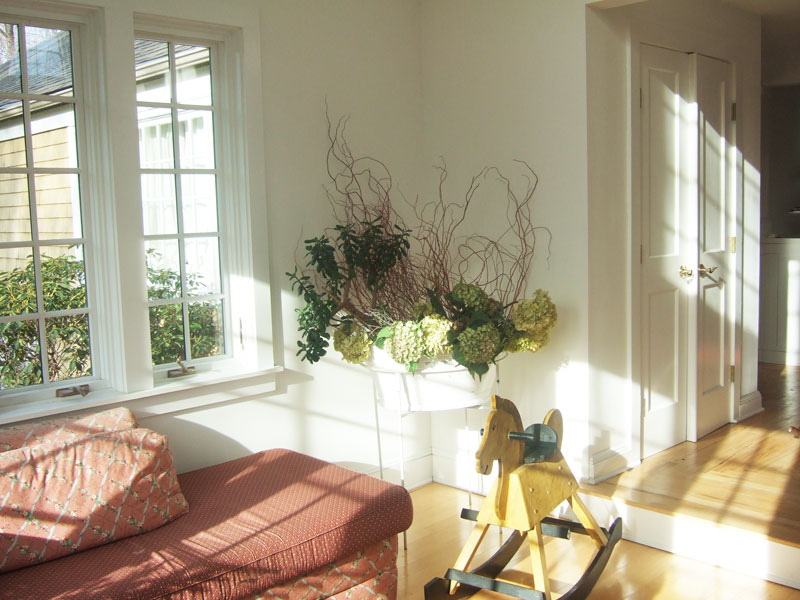 Every so often I get a question from someone and I feel that the answer is worth sharing with all similarly curious minds~ here is one now:
Every so often I get a question from someone and I feel that the answer is worth sharing with all similarly curious minds~ here is one now:
'How does the design of the house compliment the energy-efficiency and environmentally friendliness of the house? '
There are many ways that the design of the house can compliment energy-efficiency and environmentally friendliness.
- Size of the house- smaller means less to heat and cool, less to maintain, less materials, less cleaners. All of the houses we design are made to use natural materials, low or no vocs and to be extremely low maintenance, but smaller does mean less of everything and so a lesser burden on the environment and because you have to heat and cool less, a smaller carbon footprint.
- We make houses smaller by eliminating useless rooms and acknowledging 'how' people live so that the actual use of the house becomes more efficient. For example we get rid of the formal dining and living rooms that are almost never used. We design open flowing public areas and more intimate and cozy quiet spaces (such as bedrooms and dens or reading nooks). We also try to make every wall in the house a 'useful wall' either as a book case or a wall of built in cabinets or a book shelf that floats in the room as a screen and not really a wall. All of these features make for a house that is so useful and so full of storage spaces that our clients do not miss the big house full of empty and useless space. All of these features also add up to a house that is resplendent with charm and nooks and a variety of types of spaces to suit your mood. (And one thing I always say is that a well loved house is a well cared for house, a well cared for house is a long lived house and a long lived house is the most sustainable house one can ever build.)
- The orientation of the house can optimize the energy use of the house (heating cooling and electric lighting). In our climate we want to turn a house to face south when at all possible. We want to try to capture all of the southern light we can in the winter and then shade it in the summer. This can easily be done by carefully planning the placement and size of windows and the placement and size of overhangs and sun shades. To super optimize the passive solar qualities of a house we also want to make the walls and basement and roof super insulated and resistant to air infiltration. basically imagine a large rectangular thermos with its open side facing south and sealed with a glass wall. This is a really simplified version of what wee are talking about but the idea is that the house is so well insulated and oriented that it is extremely easy to heat and cool and then extremely easy to keep warm or cool once it is heated or cooled. the orientation and dispersal of windows in relation to rooms can also optimize natural lighting and reduce the need to turn on the lights for most of the day.
- The shape of the house also influences this. The less surface area the better. It turns out the most efficient shape for a house is a simple rectangle, 2 stories tall yet not too long and rectangular. Something between a cube and a long rectangle. The Darien house achieves something close to the optimum shape....its its not a pure rectangle but the volume is right. (There is a method of design and building called Passive House - started in Germany- that has been researching this for year- the optimal size and shape of a house, the percentage of windows to wall area, the point at which more insulation doesn't make sense (this is a much higher number than most people would think but there is a limit!) Those of us who have been building this way for years and years use the passive house model as the ultimate goal, each house we do is generally falls somewhere on the spectrum on the way to passive house. We have 2 actual passive houses on the boards now, but not many have been built in the us yet. Maybe 50?)
- The location of utilities and fixtures. Plumbing, electric and HVAC all work more efficiently if the locations are lined up and placed to make the runs short (so ducts, pipes wires go the shortest distance possible.) This saves money not only in materials but forever in the operational costs of the house. This solves minor problems like turning on the water and letting it run for 3 minutes while waiting for the hot water to arrive. At the Darien we made sure all of the runs were kept short. There are LEED points that are achieved only by meeting certain requirements for length of runs. We achieved these points.
- How to survive a power outage. With all of our houses we make sure that the clients have everything they need in case of emergency. Almost all of our houses get a high efficiency gas or wood burning stove that can heat most if not all of the house. Usually these items are back up heat sources (because people have become accustomed to just adjusting the thermostat and not putting wood on a fire) but they could be used as the sole source of heat. We have designed 2 houses in the last few years in which the houses were so small and so well insulated that the clients just use their high efficiency gas fireplace insert to heat the house. We also make sure that the client will have a source of water. This can be a generator powered water pump or it can be a large bathtub that is filled before the power goes out. We also make sure they have a stove they can cook on. We like to put in gas stove top so that one can always lite the burners and cook. I say a house that has a good fireplace, a large tub and a gas stove top (or even an outdoor grill) can get through any power outage,even if it lasts a week. Of course you can also add a generator to the design (which we often do) but remember that they are loud and polluting and do run out of fuel .I have heard many a story of the family that has a large built in/ automatic generator but when the power goes out realizes that the tank is all but out of gas. And then they have to get in line with all of the other people waiting for gas delivery that could take days. I hate to ONLY be dependant on a generator. All off the grid options should be taken care of first, then a generator can be added. Solar panels can also be hugely useful in a power outage, even without battery back up. We really look at incorporating all aspects when designing for 'off the grid' living.
Small, Modern, Sustainable, Dream House on Rainbow Lake
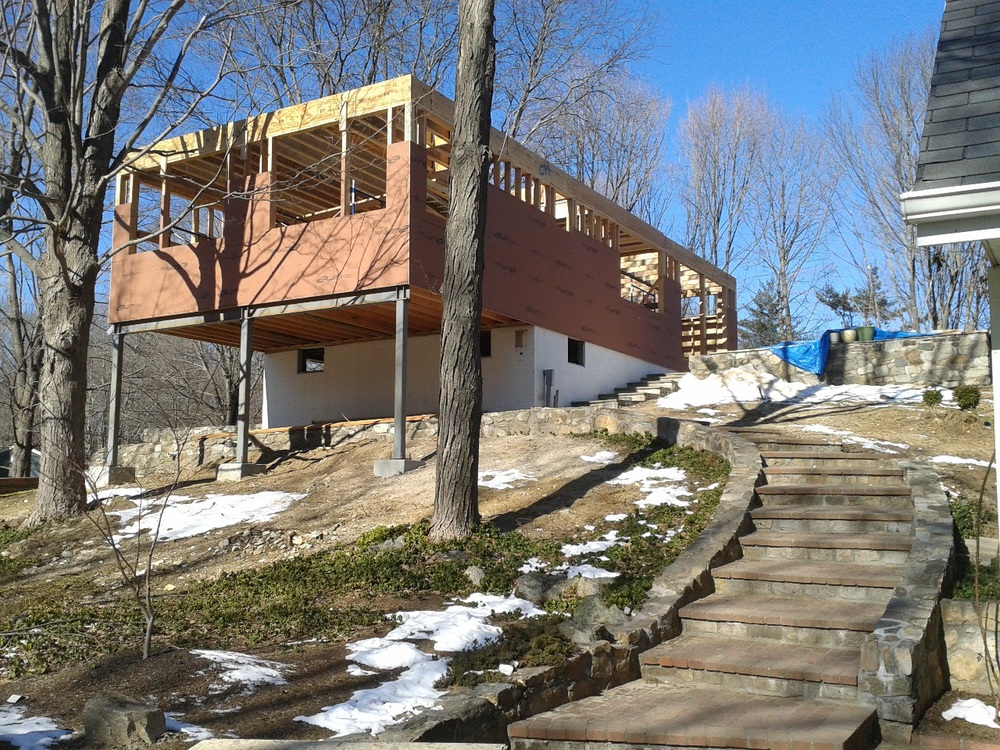
One of our new houses is currently going up in Ridgefield! This 2,100 sf , two story, super-efficient, clean, green, brand new home will be the retirement home for a couple from New York City. The very small 1,000 sf 1950's era home that sat on this hill overlooking Rainbow Lake was just too small and had too many physical problem to keep. All but the exterior foundation walls were removed, a new sub floor and cantilever structure were put up and now framing is in full gear. (You can see images of what it will look like in the 'On the Boards' Section of our website.)
This house will be fun and different because not only will it be small and very sustainably built, but it will be a modern home. Brio54, a company out of Milford that specializes in Modern Green Homes is our partner builder in this endeavor. Our mutual goals: to build super efficient, modern, smaller homes that are extremely cost effective, beautiful and simple.
Some of our basics specifications for this model are:
- Thick, super insulated walls, floors and roofs
- Taped Zip Sheathing (that serves as an air barrier and has moisture resistant features as well)
- Air sealing throughout the entire house
- A rain screen (air space) between sheathing and siding
- Natural Cedar siding that will never be or have to be treated (will weather naturally)
- High efficiency window with U values that average approximately.26
- 2 Minisplit heating and cooling units
- 2 High efficiency stoves- 1 gas, 1 wood (for back up heating and aesthetic enjoyment)
- An ERV
- All LED lighting (and lots of natural light!)
- A back up generator
- A water filtration system
- All natural, healthy, No VOC, sustainable finishes
- Future elevator ready
This house will be a super comfortable and very low maintenance place to live. This it is not the MOST energy efficient house we have built and it will not be able to take advantage of active solar panels (due to tree coverage), and it has more windows than it truly should for optimum efficiency and passive solar orientation (the smallness of the house, the awesomeness of surrounding views and the desire for lots of natural light overruled.)
Though all of these things are true, it will still be a far better house than most built today. It will be extremely energy efficient and cost very little to operate and maintain and most of all it will be quiet, healthy and comfortable and seamlessly retain an ideal room temperature and humidity. It will be very reasonably priced, coming in at less than $200/ sf.
It will also be an 'off the grid' ready house. The high efficiency wood and gas stoves will be able to keep the house heated throughout a black out and the back up generator can cover lights, water and refrigerator. Down the road if the option of Photo Voltaics open up (if the highly loved giant tree to the south were to die or fall...) then many of the electrical services could be covered by PV in the case of a black out.
This house, to me is a great example of 'affordable super green'. It will not have every bell and whistle and it will not be Passive House or Net Zero but it will get the clients most of the way there and be a beautiful dream house to live in!
So excited to watch it going up!
~ Snowy Roofs~!
(This is a re-post from 2 years ago but I felt it was timely and so here it is again!)
Ah the snow ~ There is nothing I geek out on more the day after a snow storm than driving around looking at other people's roofs. Last night we got 22" of snow in my home town. The way snow melts off of a house roof tells the story of the roof's insulation inside.Different amounts of snow tell the story in a different way. Heavy snow will tell the story more in icicles and what I call snow slumps-large swathes of snow falling down a roof.
Why do icicles happen? Well really what is going on are called Ice Damns. Ice damns happen when heat from inside the house flows out of the house- mostly through the roof (because heat rises). When the heat flows out through the roof (because there is not enough insulation) it melts the snow that is touching the roof. That melted snow turns to water and runs down the roof until it gets to the gutter/ eave and then it starts to drip down. However since the air is very cold (less than freezing) the water turns to ice and as more water comes dripping down the icicles grow longer.
What's bad about this is that at the gutter line a LOT of ice is forming! And behind that ice the dripping down water that has not frozen yet is creeping into and behind your roof shingles, sometimes popping them up and often penetrating through to the interior of your house and then causing water damage in the ceiling near the roof eaves. Bad!
The way this problem shows after a light snow fall is with stripes on a roof. Look at these 3 pictures. All 3 of these houses are neighbors, they face the same direction. ( and yes, sun and wind can often throw off the results!) They quickly reveal the levels of insulation in each house.
House #1 has very poor insulation. You can see the white stripes at each roof rafter. There is likely no insulation between the rafters which is why you can see the black asphalt shingles showing. The heat from the house has poured through and melted all of the snow off the roof. Where the rafters are, the heat gets though more slowly and thus there is still a bit of snow clinging there- un-melted. You can also see at the over hangs and the porch roof below there is still all snow in tact. That is because there is no heat flowing through there- just cold outside air.
House # 2 is less 'bad' but you can see the same patterns emerging. This house may be moderately insulated in the floor of the attic/ above the living space.
By the way if you ever see the opposite- broad white stripes and thin black ones where the rafters are- that means there is some decent insulation in the rafters- probably batt insulation- but it pulls away from the rafters, or is not well installed, so it is letting heat sneak out right along the rafter lines.
The third house (below) was recently built and I watched it go up and I happen to know that it was very well insulated with blow in insulation and sheathed with the Zip System which provides a great air infiltration barrier which inturn makes insulation perform to its highest potential. Good job! All of the snow is in tact! No heat is leaking through!
Here is an example of the detail for a decently insulated house:
Have a look at your roof today and the next few days as your roof melts! Do you need more insulation?
BTW: simply insulating your roof can cut hundreds and hundreds of dollars off of your heating and cooling bill per year. Payback times for this kind of work are usually less than 2 years! Why not !!??
Happy sledding ~ Elizabeth
Happy New Year!
 Jojo and I have to say that we are glad 2012 is over! It was not a bad year, it is more that for the last 4 years of this horrid recession everyone has been saying 'this will not end until after 2012'. For some reason, I could not believe that. Back in '09 I was sure things would turn around in '10. In the summer of '11 things seemed like they might be turning around for sure! But alas...the recession HAS lasted for 4 years. Especially for all of us in the building industry and for many other creative fields.
Jojo and I have to say that we are glad 2012 is over! It was not a bad year, it is more that for the last 4 years of this horrid recession everyone has been saying 'this will not end until after 2012'. For some reason, I could not believe that. Back in '09 I was sure things would turn around in '10. In the summer of '11 things seemed like they might be turning around for sure! But alas...the recession HAS lasted for 4 years. Especially for all of us in the building industry and for many other creative fields.
2013, for me, represents H O P E and so far it seems to be working. We have some very exciting jobs just starting or on the horizon. We have two or maybe three Passive Houses in the works. One LEED home and a number of lovely little additions. At this moment we have a super green little modern house under construction on a lake in Ridgefield. And a fresh new office space to work from.
I wish for all of my friends in the building industry and all of those in other industries that have suffered these four years to have a prosperous, stress free and healthy next 4 years. And great happiness also to all of those who have not suffered. It is time to move forward!
A New Office in Ridgefield!
Trillium Architects is opening a new office location in Ridgefield. In pursuit of a simpler life and less of a daily commute, Elizabeth DiSalvo (principal and owner) has moved Trillium to Ridgefield, CT. Trillium will still serve the same client base of Fairfield and Westchester Counties and beyond and continue to focus on sustainable, energy efficient, beautiful, healthy homes.
Elizabeth grew up in Ridgefield and after 20 years living in Los Angeles, Colorado, and NYC, returned to Ridgefield to live in 2006. Trillium Architects was founded in South Norwalk in efforts to reach a broad client base and begin promoting green residential building. Now that Trillium is established as perhaps the most experienced green residential architecture firm in Connecticut, Elizabeth felt free to try to live a more sustainable lifestyle by locating her office close to home
So much of what we promote with our architecture is 'lifestyle' that enhances health and happiness as well as being good for the environment. Please do not hesitate to call for any of our services, no matter where your home is located. We look forward to working with you!
Re-post. AC units and Split System Heat Pumps
I get a lot of questions about cooling a home and HVAC in general. We specify air-to-air heat pumps on most of our jobs these days. They are similar to 'geothermal' which is air-to-water or air-to-ground heat pump technology, except you don't have to dig a hole in the ground.
We find the air-to-air heat pumps (also called 'splits or 'minisplits'), more efficient, much less expensive and less temperamental to install. People still say 'what about Geothermal?' Well, we specified our last geothermal systems about 4 years ago and I don't see any reason why would specify one again with these great units on the market!
Here is a great article by Alex Wilson of Environmental Building News that compares cooling options of all types:
Choosing an Air Conditioner
Understanding the options with room air conditioners, central air conditioners, and heat pumps.
 The outdoor unit of a Daikin mini-split air-sourceheat pump in Putney, Vermont. Click to enlarge.
The outdoor unit of a Daikin mini-split air-sourceheat pump in Putney, Vermont. Click to enlarge.Photo Credit: Alex Wilson
I have never owned an air conditioner, and I don’t have any immediate plans to change that. But if I did, what would I look for?
Answer:
For only occasional use and when you don’t want to spend more than $1,000, the options are limited to room air conditioners, which are most commonly installed in windows. These cool the rooms in which they are installed, though in a small house or one that’s very-well-insulated and tight, a single window unit may be able to cool much of the house.
Most room air conditioners are either installed in a double-hung window or in an opening in the wall specially created for the air conditioner. Special models are available that can be used in casement windows, though installation is trickier.
Window air conditioners are usually installed in the late spring or summer and removed in the fall. Because they don’t seal tightly in the window, they should not be left in place during the winter months, as they will result in cold drafts. Room air conditioners that fit into custom openings through the wall may be left in place as long as they are fairly well-sealing (most are not), and if they are removed the opening should be carefully sealed for the winter.
For whole-house cooling, central air conditioners or heat pumps are used, and chilled air is distributed through ducts. Heat pumps offer the advantage of being able to provide both cooling and heating—by reversing the refrigerant cycle seasonally. If I were putting in an air conditioning system and my budget allowed, I would install one of the new-generation mini-split air-source heat pumps. (Very significant for those of us in the Northeast, the cost of delivered heat from these heat pumps is usually lower than that of oil.)
Room air conditioner efficiencies and performance
Room air conditioner performance is reported as the Energy Efficiency Rating (EER), which is a measure of the energy output in Btus (British Thermal Units) per hour divided by the energy input in watts, assuming standard conditions (usually 95°F outside temperature and 50% relative humidity).
Federally mandated efficiency requirements for room air conditioners vary depending on size, ranging from an EER of 8.5 for models over 20,000 Btu/hour to 9.8 for models in the 8,000 to 14,000 Btu/hour size. To meet the Energy Star standard in these size categories, the EER must be a minimum of 9.4 and 10.8, respectively. The thresholds are somewhat more relaxed for the smallest units.
Today’s best room air conditioners have EERs over 11.5, but relatively few exceed 10.8.
SEER ratings for central air conditioners and heat pumps
Central air conditioners and air-source heat pumps in cooling mode are typically rated on a seasonal bases using the seasonal energy efficiency rating (SEER). This is the total seasonal cooling output in Btus divided by the watt-hours of electricity consumption.
Central air conditioners and air-source heat pumps must have SEER ratings of 13.0 or higher. On January 1, 2015, those standards are scheduled to be tightened. To qualify for the Energy Starstandard, central air conditioners and air-source heat pumps both must have SEER ratings of 14.5 for split systems (separate indoor and outdoor components) or 14.0 for packaged units.
The best central air conditioners and air-source heat pumps today have SEER ratings above 22.
Moisture removal with air conditioners
All air conditioners remove moisture, as described in last week’s blog. While there are no federal requirements or measurement standards for moisture removal, most manufacturers list moisture removal in pints of water per hour. As a first step, you must properly size an air conditioner to achieve good moisture removal (see below). If humidity is a problem, look for models that are effective at moisture removal. Models with variable-speed motors are typically more effective at moisture removal.
Discuss moisture removal with a dealer or air conditioning contractor. Your particular situation and humidity conditions may inform the product recommendations.
Sizing air conditioners and heat pumps
Particularly with central air conditioners and heat pumps, sizing is key to successful performance. With an oversized unit, frequent on-off cycling will occur, efficiency will drop, and moisture removal will be poor. Sizing requires carrying out detailed cooling load calculations; it is not something that should be done using rules of thumb. The sizing of ducting with a central unit is also very important, both for efficient operation and noise control.
Making decisions
A knowledgeable air conditioner salesperson should be able to help you pick out a quality room air conditioner. Insist on an Energy Star-listed model, ask about moisture removal, and then consider technical support, warranties, manufacturer reputation, and service in making your buying decision.
With central air conditioners and heat pumps, talk with air conditioning contractors and suppliers, but be aware that specific contractors may push only those products they are most familiar with or manufacturers they represent. The latest mini-split air-source heat pumps from such manufacturers as Mitsubishi, Daikin, Panasonic, and Fujitsu offer—in my opinion—the best option available today.
If the air conditioning contractor you contact doesn’t provide these systems, I would suggest that you seek out other contractors or suppliers before proceeding with a purchase.
The information above and in our GreenSpec guide should help you find the right central air conditioners and heat pumps.
Alex is founder of BuildingGreen, Inc. and executive editor of Environmental Building News. He also coauthored BuildingGreen’s special report on windows that just came out. To keep up with Alex’s latest articles and musings, you can sign up for his Twitter feed.
Posted by Alex Wilson on July 11, 2012
LED Bulbs
Please check out this great article on LED bulbs if you are interested in learning more about saving a lot of money and energy while getting the great light quality of my 'personal bulb favorite" ~ the LED!

http://greenspec.buildinggreen.com/content/beat-bulb-ban-led-replacement-lamps-new-light
At Trillium we have been specifying only LED can lights for 5 years now. They just keep getting better. The light quality is great, they turn on to full light capacity right off the bat and they save a ton of energy. Right now almost every non-decorative light fixture in my house is an LED. That is about 20 lights and the vast majority of the lighting in the house. Each of those bulbs cost about $1.00 a year in electricity.
One of the complaints about the bulbs are cost. The most popular/ famous bulb right now is the Philips EnduraLED. These are most of what I have in my house. I have never paid more than $15 for one. There is a comment on the bottom of this article referring to payback times, but that comment quotes the price of the Philips EnduraLED as $25. So cut the payback times in half. The prices are dropping on these bulbs all of the time.
Also none of our residential projects have had the issues with flickering or dimming problems noted in the article. LEDs do not dim 100%. They dim to anywhere form 80-90%. This is getting remedied as the bulbs evolve but so far does not seem to represent a huge problem to the user.
The one issue I have had to adjust to with these bulbs is that they are brighter than you think they will be. We have had to learn to draw in less lighting points into our electrical lighting plans. For instance, instead of putting 6 cans in a kitchen we may only put 4. This actually is a great money saver! But it is a difference to designers. YOu have to learn to think in a slightly new way about creating the 'lighting experience' of the home.
Decorative LEDs are also on the rise and the last LEED home we did used many of these to great effect. The light is a very nice soft white. And its a very white-white...not yellowish-white, not bluish-white like many CFLs.
We highly promote the use of LEDs here at Trillium. If you have any questions about them please feel free to call the office!


